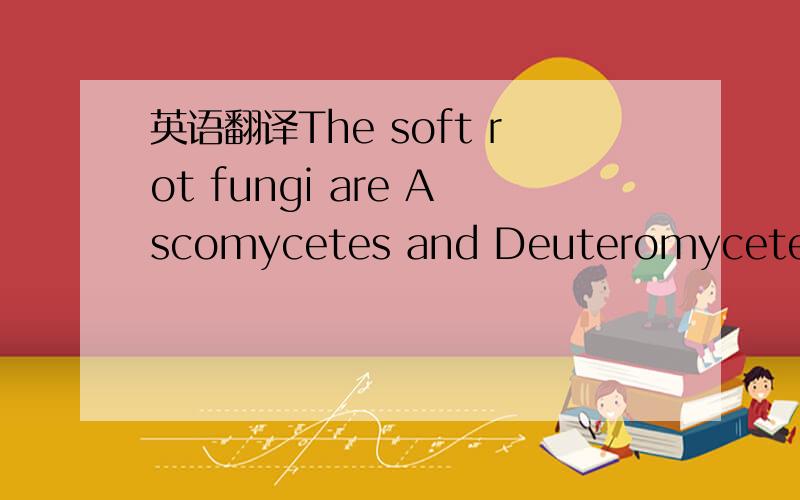英语翻译The soft rot fungi are Ascomycetes and Deuteromycetes th
来源:学生作业帮 编辑:百度作业网作业帮 分类:英语作业 时间:2024/04/28 12:12:35
英语翻译
The soft rot fungi are Ascomycetes and Deuteromycetes that decay watersaturated (but not totally anaerobic) wood,as well as wood prone to fluctuating moisture regimes.Soft rot fungi are slower and less aggressive decayers than white and brown rot fungi,and are probably less important degraders in a quantitative sense.They attack the polysaccharide
component of wood preferentially,but appear to have some ability to decompose lignin (Dix and Webster,1995).Soft rot fungi have received little research attention,and their degradative mechanisms remain unknown.
Fungal leaf litter decayThe processes by which fungi degrade leaf litter,as opposed to woody litter,arepoorly understood.In some cases,leavesare colonized shortly after they fall byBasidiomycetes.For example,Marasmius
androsaceus is an early colonizer and
degrader of pine needles,a relatively recalcitrant
and long-lived form of leaf litter
(Hudson,1986; Dix and Webster,1995).
Older analyses indicate that conifer needles
contain significant levels of lignin
(Theander,1978),but it remains to be
shown whether the Basidiomycetes that are
early colonizers of leaf litter are ligninolytic.
In most cases,leaf litter decomposition
is more complex,involving a succession
of biodegradative activities that
precede attack by lignocellulose degraders
(Hudson,1986; Dix and Webster,1995).
The process typically begins with colonization
by bacteria,Ascomycetes,and imperfect
fungi that consume the least
recalcitrant components present,e.g.
sugars,starch,and low molecular weight
extractives.The cellulose present in nonlignified
leaf tissues is then attacked by
some of these organisms,but there is no
evidence that lignin is degraded during this
early stage of decay.Subsequently,the
remaining lignified litter is modified by
fauna such as earthworms,millipedes,
slugs,and termites,which macerate lignocellulose
mechanically in a process that
releases some digestible cellulose.第四部分
The soft rot fungi are Ascomycetes and Deuteromycetes that decay watersaturated (but not totally anaerobic) wood,as well as wood prone to fluctuating moisture regimes.Soft rot fungi are slower and less aggressive decayers than white and brown rot fungi,and are probably less important degraders in a quantitative sense.They attack the polysaccharide
component of wood preferentially,but appear to have some ability to decompose lignin (Dix and Webster,1995).Soft rot fungi have received little research attention,and their degradative mechanisms remain unknown.
Fungal leaf litter decayThe processes by which fungi degrade leaf litter,as opposed to woody litter,arepoorly understood.In some cases,leavesare colonized shortly after they fall byBasidiomycetes.For example,Marasmius
androsaceus is an early colonizer and
degrader of pine needles,a relatively recalcitrant
and long-lived form of leaf litter
(Hudson,1986; Dix and Webster,1995).
Older analyses indicate that conifer needles
contain significant levels of lignin
(Theander,1978),but it remains to be
shown whether the Basidiomycetes that are
early colonizers of leaf litter are ligninolytic.
In most cases,leaf litter decomposition
is more complex,involving a succession
of biodegradative activities that
precede attack by lignocellulose degraders
(Hudson,1986; Dix and Webster,1995).
The process typically begins with colonization
by bacteria,Ascomycetes,and imperfect
fungi that consume the least
recalcitrant components present,e.g.
sugars,starch,and low molecular weight
extractives.The cellulose present in nonlignified
leaf tissues is then attacked by
some of these organisms,but there is no
evidence that lignin is degraded during this
early stage of decay.Subsequently,the
remaining lignified litter is modified by
fauna such as earthworms,millipedes,
slugs,and termites,which macerate lignocellulose
mechanically in a process that
releases some digestible cellulose.第四部分

软腐真菌指的是腐蚀水饱和(但并不完全厌氧)的木材和水分状态不稳定的木材的子囊菌和半知菌.软腐真菌的腐蚀作用弱于白色和棕色腐真菌,而且在数量上也不是最常见的降解菌.它们有选择性地腐蚀木材中的多糖成分,却似乎对腐蚀木质素有一定办法(迪克斯和韦伯斯特,1995年).针对软腐真菌的研究甚少,它们的降解能力仍属未知.
落叶的真菌腐烂
真菌降解落叶的过程不像木质垃圾的降解那么为人所熟悉.有时叶子掉落后马上会滋生出大量担子菌类.例如,安络小皮伞菌是松针掉落后最早出现的降解菌,松针相对于其它落叶而言更难降解(哈德森,1986年;迪克斯和韦伯斯特,1995年).早期的分析表明,针叶含有大量的木质素(西恩德,1978年),但滋生于落叶中的担子菌类是否属于木质素还未得到定论.通常落叶的腐烂更复杂,因为在木质纤维素降解因子介入前,已经发生了一系列的生物降解反应(哈德森,1986年;迪克斯和韦伯斯特,1995年).首先,细菌在落叶中繁殖,子囊菌和半知菌会消耗最容易降解的成分,包括糖类、淀粉类和低分子提取物等.接着,非木质化落叶中的纤维素会被这些有机物攻击,但并没有证据显示木质素在这个阶段就被降解了.最终,剩下的木质化成分被生物体消耗,例如蚯蚓、百足虫、鼻涕虫、蚂蚁,它们将木质纤维素软化,并留下一部分可消化纤维素.
落叶的真菌腐烂
真菌降解落叶的过程不像木质垃圾的降解那么为人所熟悉.有时叶子掉落后马上会滋生出大量担子菌类.例如,安络小皮伞菌是松针掉落后最早出现的降解菌,松针相对于其它落叶而言更难降解(哈德森,1986年;迪克斯和韦伯斯特,1995年).早期的分析表明,针叶含有大量的木质素(西恩德,1978年),但滋生于落叶中的担子菌类是否属于木质素还未得到定论.通常落叶的腐烂更复杂,因为在木质纤维素降解因子介入前,已经发生了一系列的生物降解反应(哈德森,1986年;迪克斯和韦伯斯特,1995年).首先,细菌在落叶中繁殖,子囊菌和半知菌会消耗最容易降解的成分,包括糖类、淀粉类和低分子提取物等.接着,非木质化落叶中的纤维素会被这些有机物攻击,但并没有证据显示木质素在这个阶段就被降解了.最终,剩下的木质化成分被生物体消耗,例如蚯蚓、百足虫、鼻涕虫、蚂蚁,它们将木质纤维素软化,并留下一部分可消化纤维素.
英语翻译The soft rot fungi are Ascomycetes and Deuteromycetes th
Are the toy cars soft and fluffy?
英语翻译Powdery mildew fungi are obligate biotrophic pathogens t
what are the differences between 'hard coal' and 'soft coal'
英语翻译fungi bring about the decomposition of dead organic matt
英语翻译The soft handwriting reflected a thoughtful soul and ins
英语翻译But the attacks were and are silly—and miss the point.Th
英语翻译When the routine bites hard And ambitions are low And th
The dress smooth and soft
英语翻译wood was rot.
( )of the apples in the fruit bowl are soft and sweet.
求英文解释与分析The fungi absorb moisture and mineral salts from the